#roar 2022
Explore tagged Tumblr posts
Text


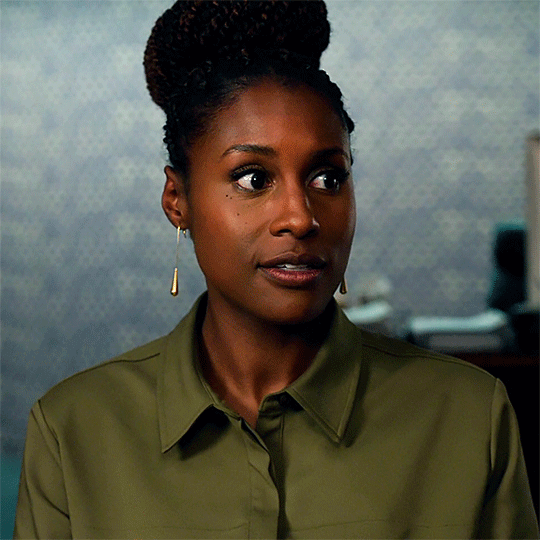
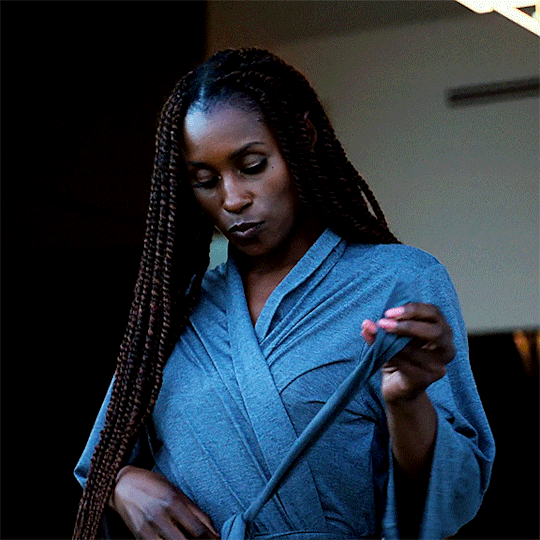


ISSA RAE in ROAR (2022)
#roar#roar 2022#roaredit#issa rae#issaraeedit#apple tv#showedit#*mygifs#appletvedit#appletvsource#tvfilmgifs#userbbelcher#userstream#femaledaily#wocedit#wocdaily#userserin#userrobin#useroptional#tvfilmspot#mediagifs#i enjoyed making this (staring at issa rae for an hour)
124 notes
·
View notes
Text
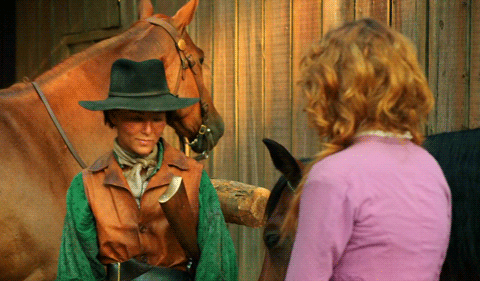
1 note
·
View note
Text

ive been waiting soooo long to do this!!!!!!
looking back on this year's art, its just changed..an unbelievable amount..... i dont think i showed that very clearly here but you can still see!! im really proud of this year's art!! i tried to pick ones that i thought showed the most improvement in as much parts i could rather than picking my favourites haha
this year i made my own template, as you can tell its very me, but last year i found a random one from search results lol

#hoping i dont make any pieces for the end of this month iwanna put here LOL#i really love the one i put for december this year tho#i also have one from 2022 but you could not even waterboard that out of me#its already scary posting the 2023 one skfsdjofefg#also fun fact the one from septembre 24 was a continuation/redraw(?) of the one from july 23!#thunder roars
24 notes
·
View notes
Text

#Alluri Sitarama Raju#Ram Charan#RRR#rise roar revolt#Roudram Ranam Rudhiram#rrr movie#rrr film#rrr 2022#tollywood#S. S. Rajamouli#desiblr#desi movies#Indian movies#naatu naatu#rrr fandom#rrr (2022)#hug kiss marry kill
14 notes
·
View notes
Text
“I’m your KING,” and Jade’s following “ok this conversation is over” as no one talks to my Kit like that but also as words falling on deaf ears, a loved one too far gone, too far into the claws of the Wyrm, the Crone’s clutches. As, is it too late? Is it even our Airk hearing our words, are these truly his words leaving his mouth, or is it possession? Or has he truly been swayed so far from us that he would actually talk this way to Kit, his beloved sister, who came so far to save him, to face this cold shadow wearing her twins skin? “This conversation is over,” as, he isn’t in a place where our words can reach him, if even Kit, his double and his twin, can lay her heart out on the dusty floor of this old temple and say “you’re my brother” and mean, I love you, and it elicits no more response than dismissal, this cold, this separation? To Jade’s ears, there’s no more to be gained from this conversation than pain for Kit. The line “this conversation is over” as anger, as grief, as loss
#willow 2022#it’s so good ok#the lines the delivery??#the break in Kit’s voice as she says brother?#the roar on Airk’s delivery of King?#jade claymore#kit tanthalos#tanthamore#airk tanthalos
60 notes
·
View notes
Text
On Bheem acting as a "mediator" between Ram and Seetha
[Disclaimer: this is not about shipping wars, it's just an analysis because I find the dynamic interesting. Whether you ship rambheem or ramseetha or both or neither is irrelevant for this, and beside the point.]
Click here to read this post on Ao3
It always drew my attention that most of Ram and Seetha's interactions seem to be mediated by Bheem. That is, have him as a middle man; there is the obvious part where Bheem brings Ram back to Seetha, but it's more than that. Ram also only writes to Seetha because of Bheem. When they first reunite, it is Bheem who joins their hands together. Even during Etthara Jenda, there is no moment with just Ram and Seetha; Bheem is always there. In fact, there is a brief moment with only Bheem and Seetha, but none with only Ram and Seetha. It seems that Ram and Seetha only ever meet through Bheem, as if he's the thread connecting them.
I thought that was interesting and I think I'd like to expand a bit on that. At first I thought it was just because the movie is obviously focused on Bheem and Ram and their relationship and the other characters are... Just not that explored outside of their relationship to the core characters and/or the plot. But I think there is also some symbolism there that is worth exploring.
When Ram leaves Seetha, he tells her that a part of him will always be with her. I'm working with the English translation here, because unfortunately I don't speak Telugu, but I did check the Portuguese, Spanish, and Italian translations and they all pretty much translate the same, so I'm going to assume that the translation here is accurate and communicates everything it's supposed to communicate. That means that leaving Seetha is also leaving that part of him behind. I mean, the symbolism is pretty obvious here. He takes his pendant, which was a single circle, and breaks it in two. One part he takes with him, another he leaves with her. From that moment on, Ram is incomplete.
And I think that the part that he left with her isn't just, generically speaking, half of him; I think the part that he left with her was his own humanity.
Here's why.
When Ram leaves his village, he takes two things with him: his grief and his sense of duty. That is all he has in Delhi. Well, other than his uncle, but his uncle was already in Delhi before Ram went on his mission, so I don't think he counts as something Ram "takes with him". I really doubt Ram would have asked Venkateswarulu to come if he hadn't already been in the police force before Ram was.
When we first meet Ram, the only emotion he allows himself is anger, and even then, only in private where no one can hear him. Even Venkateswarulu seems unable to really reach him. Ram is fueled exclusively by his rage, his need to do something to alleviate his grief, and his promise. He has no meaningful connections with anyone, he doesn't allow himself his feelings, and he needs to keep everything that makes him himself locked away so he doesn't blow his cover. Ram is living in nearly complete isolation and completely detached from his own feelings; he doesn't even allow himself his grief, because it would get in the way of his mission. It serves as fuel and a reminder of what he has to do, but it's not something he is actually allowing himself to feel in full.
So what is missing? He is missing his sense of community. His history, because Seetha has been a part of his life since forever, and she is also the embodiment of his connection to his village as a whole. His love and his joy, because everything that was meaningful and dear to him he left behind with her. And as time goes by... More and more, he leaves his ideals, too. By the time we meet Ram, he isn't really fueled by his need to free the land; he is fueled by his grief. When he falters, he doesn't think of the free world him and his father envisioned; he thinks of the despair he felt as he watched him die. He is doing this because he is, in a way, trying to provide meaning to his family's death, trying to save them symbolically, trying to alleviate his survivor's guilt and fulfill his promise. He gets so fixated on the weapons he forgets they're a mean and not an end. Therefore, his beliefs ended up staying with Seetha as well.
So... Community, history, love, and beliefs. Combined, I'd say that's pretty much everything that makes us human. Of course, pain is part of the human experience as well, but without those... There isn't much else left for a person.
And look, I'm not saying that Seetha makes him good or that she exists to take care of him and bring him back to himself, I want to make that clear. This isn't about anything in particular Seetha does or should do to or for him; this is about the fact that Seetha was the last good thing Ram allowed himself, and therefore his distance from her is also his distance from his own needs. The further he is from Seetha, the further he is from himself and his humanity.
I think there are at least two scenes that add credibility to that thesis: the first and most obvious one is when he is torturing Lacchu and his wristband snaps. When Ram first gets to the point of no return, when he is doing the most inhuman thing you could conceive, and he's doing it with gusto, too, because he's angry, he completely loses his connection to her. And then it immediately cuts to Seetha not only waiting for Ram, but actively asking a kid to scout and check if he is there. She is unable to find him, unable to connect again; and then it is made pretty clear that Ram has strayed too far from her. It is immediately after that moment that we learn he hasn't written to her in all these years, and one of the villagers even asks her if Ram remembers her at all. I also think it's interesting that it's the rest of the village that voices the concern for Ram and the sense of betrayal, and not Seetha; not to mention that they went to her to ask what is happening with Ram. This further cements Seetha as a representation of his connection to his own past and people: it is through her that they seek him out, and therefore, she is the link between them.
(Again, I'm not saying that she is literally the one doing the work of keeping them together; I'm saying that the movie has her, symbolically, embody the entire village. So when we are reminded of his distance from her, we are also reminded of his distance from them, and therefore, from himself)
The second scene is when he, finally, after all these years, writes to her. This is the first time in the movie where Ram actually voices his thoughts, instead of just screaming and drowning in his own memories. We know what Ram is feeling and thinking, but he never allows himself to acknowledge it. When he does, he does it through talking to Seetha; because she is the one who keeps the part of him that allows himself to feel, the part that is idealistic and that is doing this for love for the motherland rather than hatred for the British. The part that remembers what he is really fighting for.
And not only does he seek himself in Seetha, he is also only able to connect to Seetha when he stops denying himself. I actually think that's the most important part. He has spent four years isolated from her, without any sort of communication; he lost his way to her because he locked out his own humanity to be able to survive being a double agent. It is only when he unlocks it, really allows himself to feel and think and question, that he is able to find his way back to her.
And what allows him to unlock his humanity and search for her in the first place?
Bheem.
That's where his mediation comes in.
Because Bheem was the first one to crack Ram's walls at the very least since he went to Delhi, but I'd risk saying that really it's the first time since he lost his family. He kept everyone at arm's length; he threw himself into his mission as a way to avoid actually processing his grief. Of course he still had his village and Seetha, but you don't just become this repressed and guilt driven out of nowhere. Even as he's saying goodbye to Seetha and the village, Ram doesn't once smile. We see his face tight and nearly blank, the same way it was when he was first introduced, fighting that mob. There is determination, but otherwise, he is completely closed off. And he is leaving alone.
And then he meets Akhtar, and this motherfucker becomes unrecognizable.
I've joked before that he must have pulled his cheek muscles after he met Akhtar, but it is seriously a jarring difference. He spends the entire Dosti montage grinning from ear to ear, save for the "don't eat with your left hand" moment and the parts where they aren't actually together. We have never seen him give even a tight lipped smile before, and suddenly the man can't stop laughing. We have never seen him express a clear emotion, and suddenly we have him not only emoting but also showing vulnerability. Even after the montage, Ram is frequently grinning at Bheem, and he is shown with his body language relaxed when we've only really ever seen him tense. In fact, not only tense, but so tense he is frequently shaking.
It's not even just the expression of positive emotions. Meeting Akhtar also gives us our first glimpse of who Ram truly is and what he actually believes. The best example of that is the events in Naatu Naatu. For the first time ever, Ram rises up against the British. Even if it's in a small way, it's an act of open defiance that we hadn't seen before. He taunts Jake, he mocks him, he openly laughs at him (which is also curious, considering that Bheem was the one that Jake hurt; but Bheem is largely ignoring Jake, while Ram is going out of his way to antagonize him). The part of Ram that is purely rational and mission driven would have thought it better not to draw attention; so when Ram chooses to take that risk and be defiant, he is also remembering what really matters to him: protecting his people and fighting for justice. And that takes the form of protecting Bheem.
Therefore, those parts of him that had been kept away suddenly come crashing back when he meets Bheem. Bheem helps him find his way back to himself without even trying, and if he is finding the way to himself, he is finding the way to Seetha. Not to mention that it is because of the fact that he couldn't live with betraying Bheem that he wrote to Seetha in the first place. Bheem helped him find the part of him that loves and rejoices and is driven by more than just rage again. So, when he turns his back on Bheem, he is also going back to denying himself his own humanity. But he can't actually do it this time; and so, when he finds himself unable to keep repressing himelf, he writes to Seetha.
Even before that, however, Ram's connection to Seetha is only shown to the audience through Bheem, and the link between his relationship with Bheem and his relationship with Seetha is shown from the very first time we learn about her.
We are first shown the pendant during the Dosti montage. Ram was wearing it before, of course, but the movie kind of went out of its way to hide it. In his introduction, he is straight up not wearing it. The first time he is shown with it is when he is destroying that poor punching bag, and he nearly immediately wraps his hands and wrist in tape that covers it:

[ID: Screencap of Ram punching the bag, where you can see his knuckles and wrist are wrapped in tape. End ID]
Then, in the "RRR" title page, they didn't include Ram's pendant in the drawing of their hands together, even though they kept Akhtar's wristband:
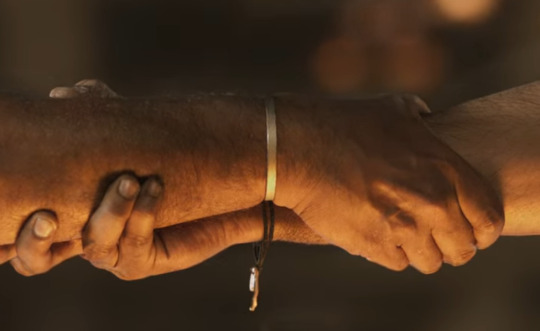

[ID: Screencaps of Ram and Bheem's joined hands when they meet; you can see that Ram is wearing his wristband. Then, when it transitions into the drawing, his wristband is no longer shown, but Bheem's is. End ID]
They're not always hiding it, and you can frequently see it on Ram's wrist if you know to look, but they don't draw attention to it and actively avoid accidentally drawing attention to it.
(But also, interestingly enough, it is first visible in the scene where Ram is talking to Venkateswarulu; and the scenes where it is most visible before Dosti are the ones where Ram is talking about killing governor Scott, and when he's helping Bheem save the child. I think this is a subtle way of hinting that this is who Ram truly is; even though he is pretending when he says that he's going to kill governor Scott, he is still closer to himself and his ideals than he was when he attacked that mob. And even more so when he helped Bheem do what they both are sworn to do: protect their people.)
Then, during the Dosti montage, they film it directly for the first time. We see Ram playing with it and acknowledging it, and we learn that it is significant to him. And then they won't stop filming it after that.
This isn't a coincidence; the pendant is the embodiment of his connection with Seetha, and, therefore, with his humanity, as previously stated. The fact that it is shown during Dosti, which is also when we first see Ram acting fully like himself, goes to show how much Bheem's friendship is helping bring Ram back. I mean, for starters, just sitting there fiddling with it and smiling is something I can't imagine pre-Bheem Ram doing. Nevermind the fact that he lets Bheem see it and doesn't even try to hide that moment of vulnerability from him.
After that, the pendant is used to highlight Ram's struggle with figuring out what he wants to do (which really means figuring out who he is) after he betrays Bheem. For example, when Ram grabs Bheem, we get a shot of him crying blood, and the blood falls right beside the pendant, in a shot that shows almost nothing but these two things:

[ID: A drop of blood falling on Ram's hand, right next to the pendant. You can seee only Ram's wrist and a bit of the holy thread wrapped around his palm. End ID]
(Also, this time, the illustration of their hands does include the pendant)

[ID: The illustration of Ram's hand that immediately follows the previous shot. The pendant can be seen wrapped around his wrist and over his palm. End ID]
Further cementing the idea that the wristband represents the last of his connection to his humanity is the fact that, in the flogging scene, Ram is wearing it on his left hand.
In every other scene, it is on his right hand. That seems to be something they were very careful about. But throughout the flogging you can see that it is on the left. In fact, they even open the scene with a shot of it:
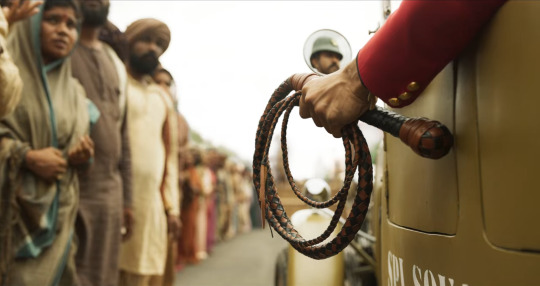
[ID: Ram driving to the square. He is holding a whip in his left hand, and the bracelet can be seen on his wrist. End ID]
Throughout the scene, it is hard to see the bracelet because of the uniform's long sleeves, but there are a few shots that confirm that it's on his left wrist:

[ID: Ram with the whip on his right hand, pulling it back. His left hand is in front of his body and the bracelet is visible. End ID]
And at the end of the scene, we can see it clearly:

[ID: Ram cradling Bheem's bloody face. His left hand, on which you can see the pendant, is holding Bheem's chin. End ID]
It's too consistent to be an accident, especially considering how it never ends up misplaced in the left wrist in the other scenes. On top of that, the movie brings up the fact that the left hand is considered dirty (in the scenes where Bheem's fake mom and Ram's real mom tell their respective children not to eat with their left hand).
Disclaimer for this part: I'm neither Hindu nor Indian, so I looked up as much as I could on the right/left significance, because I believe people should make an effort to understand the implications that don't speak directly to their experiences, especially when it comes to culture and race. If anything I say is inaccurate or offensive, please let me know, and I'll edit it. If there's anything else I'm missing, feel free to add it as well. I also assume that the cultural associations with the right and left go beyond religious significance, since Akhtar's family is Muslim and not Hindu and they also enforce the "no eating with your left hand" rule. But Ram is Hindu, so I'm also using sources that talk about its significance in Hinduism. I don't mean to imply that the two are interchangeable by that.
I found many different significances associated with the right and left sides in Hinduism (right is male, left is female; right is submissive, left is contrary; right is yourself, left is your spouse), but the most important one seems to be that right is sacred and pure, and left is profane and dirty (because that one was mentioned in every paper I found, and it was usually the first to be brought up). Hence why it's important that you eat and give offerings with your right hand, and do "unhygienic" tasks with the left. This rule also applies to Islam, which explains why Akhtar's fake mother made the same comment. The fact that this aspect of the right/left duality is brought up in the text also implies that this is the most important one in this context.
So, if the left hand is dirty and profane, and the pendant is Ram's humanity, and the pendant is on Ram's left hand in this scene... I think what the movie is telling us is that in this moment, Ram is forsaking himself. He is going against everything that he truly is and believes, and his own feelings; he is even condemning himself, in a way, because this is the kind of thing that there should be no turning back from. In that moment he is the furthest he could be from everything that is holy, and good.
(Also, from a Watsonian perspective, we know that Ram has been taught that the left hand is dirty by his mom; if he chose to change the placement of the pendament in that moment, I think that speaks volumes on how he's feeling about himself. I also think it's possible that he did it because he couldn't stand to whip Bheem with the same hand that held his reminder of Seetha).
I also find the "right hand is yourself and left hand is your spouse" significance relevant here, although secondarily. I know Ram and Seetha are not married yet, so I'm not sure if Ram's left hand already "counts" as representing Seetha, but even if it doesn't, I think the fact that Ram is putting the embodiment of himself away from the hand that represents himself and on the wrist that is supposed to (at least eventually) represent Seetha goes to show that he truly left everything that matters about himself with her. His soul is no longer resting within himself because he turned his back on it. So, it is all with Seetha. If he had left half of his true self with her before, once he whips Bheem, he fully abandons himself. All that's left of the true him is in Seetha's memories.
This is, I think, further enforced by the fact that, although we get enough shots of Ram's left wrist to confirm that it's there, what the movie focuses on the most during that scene is not its presence on the left wrist, but its absence on the right one. Ram's right sleeve is always slightly pulled up in that scene, so we can see that the wristband is not there, like the movie is constantly calling to our attention that something is wrong with Ram. On the same vein, during Komaram Bheemudo, the framing very carefully hides his pendant in most shots. They go out of their way to leave it out of frame, even in the closeup shot of Ram wiping his tear (which he does with his left hand, where the wristband is at the time).
Here are some examples of both the framing and the sleeve being ridden up:

[ID: Ram picking up the spiked whip. The shot cuts right where his left wrist would begin, but shows most of his right arm. The sleeve is ridden up til nearly mid-arm, so you can clearly see that he's not wearing the wristband. End ID]

[ID: Ram first hitting Bheem with the spiked whip. His sleeve is still rolled up, and his wrist is in the foreground, without the wristband. His left hand is behind his body, out of frame. End ID]
The entire Komaram Bheemudo scene focuses on the lack of the wristband, aka the lack of Ram's own self in that moment. He is doing everything he is supposed to be fighting against, and betraying himself in the process. So the absence of him is felt even more acutely than the displacement itself.
Then, when Ram decides that he is going to save Bheem, the opposite happens: they go out of their way to keep the wristband within the frame. Even when Ram first shows up in that scene, it is framed in such a way that the part of him closest to the viewer is his right wrist.
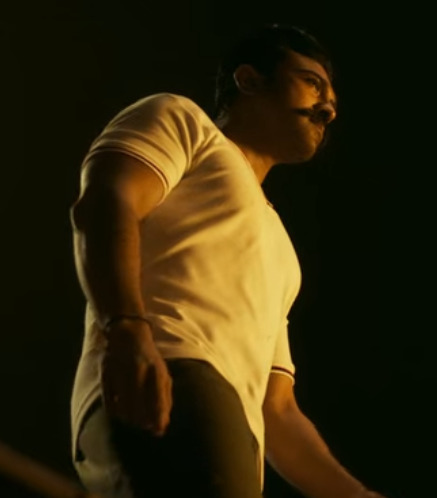
[ID: Ram walking into the scene where Bheem was flogged. It is shot from under him and to his right, so his right wrist is the thing closest to the camera. You can see the wristband on it. End ID]
Even when he is being filmed from the left, the wristband is still visible:
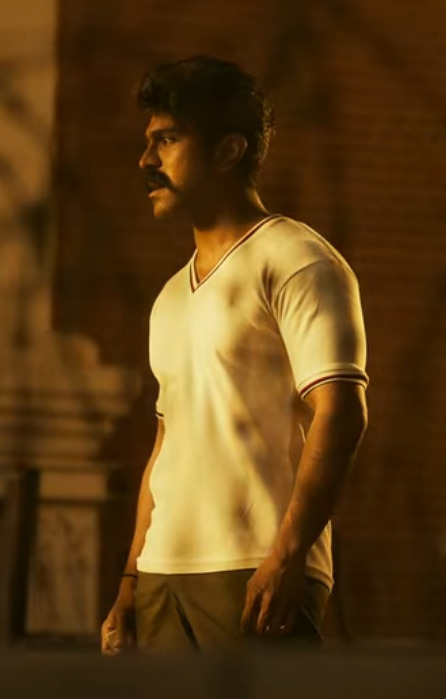
[ID: Ram being filmed from the left side as he talks to his uncle. He is shown from a 3/4 position, so we can see the wristband on his right wrist even as it is turned away from the camera. End ID]
And even when there are other objects obstructing part of him, the framing is such that you can always see it:
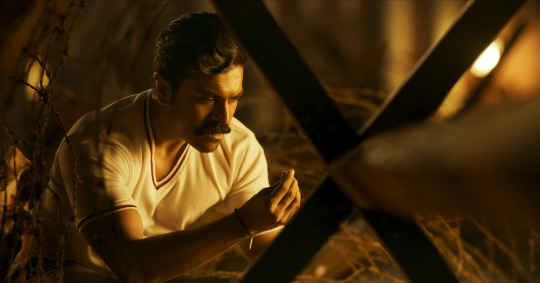
[ID: Ram looking at the blood on his hand. He is shown from within a circle of barbed wire. There is an X right beside him, but it is still framed in such a way that Ram's pendant is visible as he raises his hand to look at it. End ID]
In fact, during that scene, we get a closeup of the pendant for the first time since Ram betrayed Bheem:

[ID: Ram touching the ground, which is wet with Bheem's blood. The pendant, back on his right hand, is visible on his wrist, resting over his palm. End ID]
And the trend continues: you don't see his wristband at any point while he is talking to Governor Scott, but you do see it many times when he is rigging the weapons to save Bheem (complete with several closeups, but they are very quick). Very interestingly, when he puts Malli in the car and drives towards the hanging point, the framing is such that you can see the wristband, but only partially. Ram is being careful, but still giving himself away; he is too kind to Malli, he is too tense as he's driving, he's showing too much of himself. He's still trying to hide it, but it's enough for Scott to see.

[ID: Ram putting his hand on Malli's shoulder comfortingly as he puts her on the car. The shot is framed so that the seat covers half of the wristband, but the other half is visible. End ID]
Then Ram tries to enact his plan to free Bheem, and again the pendant is not only in frame, but also always turned towards the camera even when it means being in different positions in relation to Ram's hand:
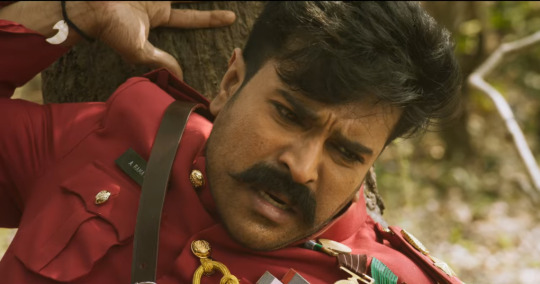

[ID: Ram when he's impaled on the tree. He throws his right hand up, and the framing ends right where his wrist does so we can see the bracelet. It is turned towards his inner arm. In the second image, he has fallen to the ground. Again, the pendant is on frame, with the pendant turned towards his outer arm and falling over his hand. End ID]
And listen, I know that I sound insane, but this is consistent. Obviously Rajamouli didn't frame every single shot with the wristband in mind, but there is a very clear pattern where the wristband is invisible when Ram is pretending to be a British officer, and visible when he's not. That's not even only after Bheem is whipped; in retrospect, they were also doing that in the first few scenes. Ram was not wearing the wristband when he was fighting that mob; he was when he was punching the punching bag, but it was hidden. Then it was shown when he was with his uncle, and even more when he was talking about killing governor Scott. When he was lying to Lacchu, it didn't appear much. Then it made a comeback when he helped Bheem save the child, and then in the Dosti montage we had a lot of attention drawn to it (not only in the obvious moment where he talks about the pendant, but also in others; for example, in the shot where they are talking and laughing, Ram's pendant is visible, despite the fact that he has his hand in his pocket).
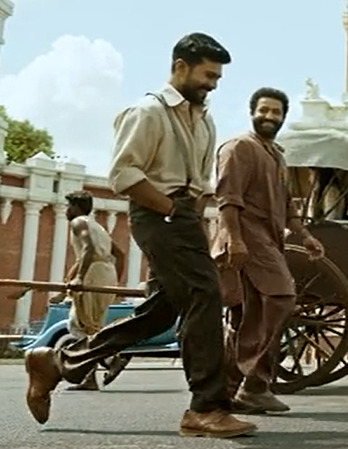
[ID: Ram and Bheem walking side by side. They are both laughing, and Ram is looking slightly down. His hands are in his pockets, but the wristband is still fully visible. End ID]
So, I think the framing matters here. If the flogging scene was drawing attention to the absence of the pendant on Ram's right wrist, these other shots are drawing attention to its presence. The more of the real Ram we see, the more of the pendant we see, again directly making the link that the wristband = Ram's humanity and true self.
Interestingly enough, it is only after he has officially saved Bheem that we get a clear closeup meant to show only the pendant again:

[ID: Ram lying on the grass after saving Bheem. He is out of focus, and his hand is extended towards the viewer. The pendant is falling over his palm, plainly visible and in focus. End ID]
If denying Bheem was denying his humanity, saving Bheem was saving it; it is back into focus, plainly visible and no longer locked away. I also find it interesting that this is when we finally get the flashback of when he gave the pendant to Seetha in the first place. At this point there's been 2h15m worth of movie and despite the fact that the pendant is very clearly referenced several times, we only get to see that moment right then. I think this implies that this is the moment when he finally connects with the part of him that's missing; it also drives extra attention to the relationship between saving Bheem and recovering that part of himself.
Not only that, but this is the first time we get a flashback that shows Ram driven by purpose, and not grief.
Ram has several flashbacks throughout the movie, but they are always of his father's death. His grief is the only thing pushing him forward. It is his grief that leads to him betraying Bheem (and I find it interesting that the pendant is also not visible in that scene, despite the fact that we get closeups of Ram's bloody right hand. I had kind of been assuming that they would show the pendant then, since it seemed to be connected to his purpose, but they don't. Now, I think that's exactly the point. The pendant is Ram's purpose, and he doesn't really have it in sight right then. He remembers the pain and the blood; he doesn't remember the ideals and hope that he had when he chose that path. He doesn't remember that this is about freedom, he only remembers that this is about a promise). It is his grief that he is thinking of when he's practicing shooting; whenever we see Ram's past, it is always focused on that one day.
The scene where he gives the pendant to Seetha is the first time we see a flashback with adult Ram. And in it we get to see Ram being tender (although he's still very serious); we get to see him talking about courage; we hear the "Vande Mataram" chant, a scream of love for the motherland rather than trauma and resentment; we get to see Ram being larger than life, motivated, focused. I mean, hell, Seetha puts a tilaka on his forehead. That is supposed to help one's focus, health, and mental stability, yes; but it's also related to the search for self awareness. Ram leaves with Seetha his humanity, and Seetha says goodbye by trying to connect Ram deeper with himself. Obviously, that doesn't last. But once again, the link that his connection with Seetha and the pendant = his connection to himself is strengthened.
And so, reliving that memory means finding that connection to himself again. It means finding his drive, his courage, his motive. It seems that, finally, Ram has remembered himself. And he achieved it through his love for Bheem, who, just like Seetha, now embodies his ability to connect to others, fight for what's right, and be himself.
I believe that this is also why, after that scene, the pendant stops being a wristband and becomes a necklace.
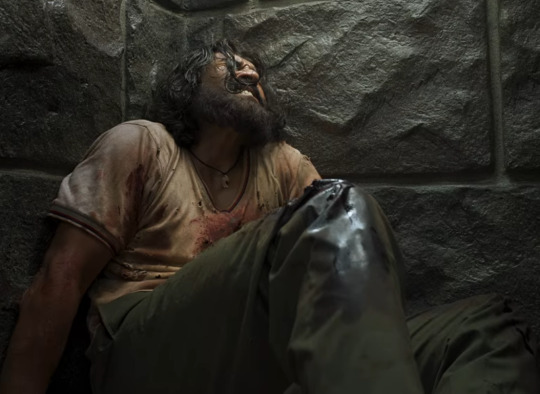
[ID: Ram in prison, groaning and throwing his head back. Due to the movement, you can see the pendant is now on a necklace. End ID]
A wristband is easier to see; it is something that you can always bring back to your line of sight. Wearing the pendant on a wristband, Ram is keeping it as a reminder; he is trying to make sure he doesn't forget who he is and what he's fighting for. We even see it serve that exact purpose during the torture scene with Lacchu. But a necklace doesn't need to be seen. Putting the pendant on a necklace means keeping it closer to his heart. At this point, Ram has internalized the pendant, and doesn't need to look at it to remember who he is; it's already a part of him. Because once he remembered who and what he's fighting for, and found again his humanity and drive, he didn't need it as a reminder anymore.
It's also worth noting that Seetha wears her own pendant as a necklace as well; when Ram puts it on the same place, it implies that their connection is stronger. As if they are no longer displaced and there is no longer the chasm between the Ram Seetha remembers and the Ram Ram sees.
Additionally, the pendant was originally a necklace before Ram broke it and gave it to Seetha:

[ID: Ram talking to Seetha before he leaves the village. He is wearing the pendant, which at this point is a full circle, as a necklace. End ID]
Then, immediately after he tears it, it becomes a wristband:

[ID: Ram spreading his arms as he gets on the boat that will leave his village. This is after he has broken the pendant, and he is no longer wearing it as a necklace; instead, we can see that he is wearing a wristband. End ID]
So, it being a necklace again also implies that he is going back to his roots, reconnecting to who he was and what he wanted when he first went on this mission.
Which is why it's extremely interesting that Bheem is the one to give Ram back the other half of the pendant. You'd expect it to be Seetha when they are reunited, but instead, Bheem takes it to him before he brings Ram back to Seetha. Which in turn reminds me of what he tells Seetha before going to rescue Ram:
"I will bring you back your Ram even if I have to lay down my life."
Again, I am going with the English translation, and I don't know what they say in the original, but I did once again check the Netflix translation and the translations in other languages that I speak/understand and they all kept the "your", except for Italian, so I am going to assume that this translation is accurate and close to the original Telugu.
This wording striked me as odd when I first watched, because why is Bheem emphasizing that Ram is Seetha's in that moment? Obviously they are engaged, so, you know, makes sense, but why is he emphasizing it? Rewatching it now, I think I get what he means: it's not just that he will bring back Ram; it's that he will bring back the Ram that Seetha knows. The real Ram. It's not enough to bring back Alluri Sitarama Raju; he is telling her that he will bring her the Ram she knows and loves, the one who's a rebel and who's whole. Which is why it makes sense that he takes Seetha's half of the pendant with him.
That is another part that first striked me as odd, because it seemed to directly contradict another thing he told her:
"Seetha shouldn't go looking for Ram. Ram should come to wherever Seetha is."
So why bring the pendant with him before reuniting Seetha and Ram? If this was simply about bringing Seetha and Ram back together, it would make no sense for Bheem to do this. Which is why I think that it's more than that; when he brings Ram back the pendant, when he puts the two halves back together with his own hands, he is making Ram whole again. Not just because he is saving him from death, but also because he is offering Ram his forgiveness and friendship again; and Ram needed that in order to move on from what he did, and find the person that he tried to bury and nearly forgot about these last 4 years.
In other words, the union of the two parts of the pendant is less about reuniting Ram and Seetha as people, and more about reuniting Ram with what Seetha represents; which, in turn, allows him to come back to Seetha as the Ram that she knew and missed.
(Of course, Ram will never go back to being exactly the same, and the pendant will always have the marks of the break; but it's rebuilding itself, and that's what matters)
And that is a natural conclusion to their relationship, because Bheem had been helping Ram find himself since the moment they met, as shown in the Dosti montage and the jarring differences between how Ram was and acted away from Bheem versus near Bheem. Not to mention Naatu Naatu, the first and only moment where Ram didn't just stand by and watch as his people were done injustice before he decided to save Bheem. The Ram that Seetha knew would never have come back to her if Bheem hadn't been there to help him find his humanity again. Which is why Bheem is the one to put the pendant together, and also why he is the one to put Ram's hand in Seetha's when they reunite; because without Bheem, Ram wouldn't have found his way back to her, because he wouldn't have found himself again.
I also think this is one of the reasons Bheem also puts a tilaka on Ram's forehead; of course, there is the fact that he is giving Ram the getup that he is known for, but remembering how Seetha had once put a tilaka on Ram's forehead, I think the fact that Bheem does it the second time also reinforces the connection between his relationship with Bheem and his relationship with Seetha, as well as the idea that he is reconnecting Ram with himself, just like Seetha tried to do when they were first parted.
Bringing Ram and Seetha together meant reconnecting Ram with his true self, and because Bheem was the one who reminded him who he was and what he was fighting for, he needed to be the one to do it.
#rrr#rrr 2022#alluri sitarama raju#komaram bheem#rise roar revolt#bheem#raju rrr#rambheem#ramseetha#meta#rrr meta
64 notes
·
View notes
Text



Old Outlaws: McCall and Cribbens
#so this was my first time drawing willem#i think he turned out alright#honestly better than i thought#please go easy on me though#it's my first drawing in a while#but here's my two favorite outlaws#i love them#and i wanted to do a crossover#so here it is#silas mccall#roar (2022)#joe cribbens#dead for a dollar#alfred molina#willem dafoe#fan art#cowboys#cowboy art#fanart#illustration#illustrations
26 notes
·
View notes
Text
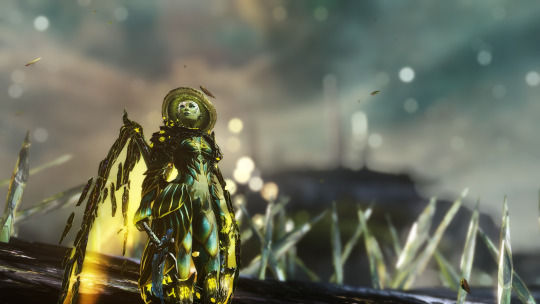
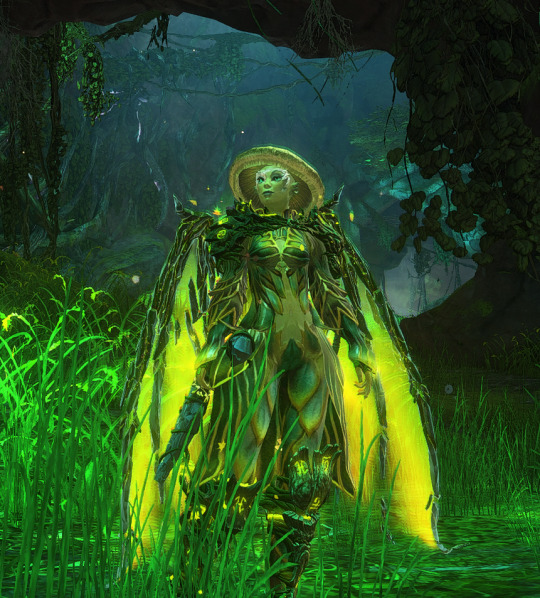
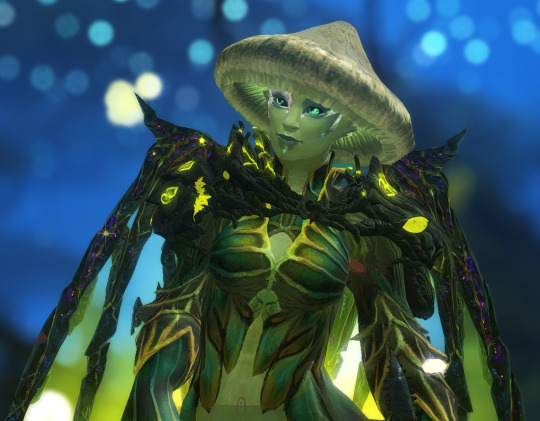
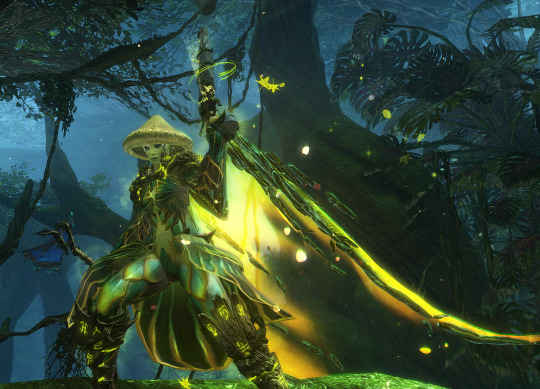
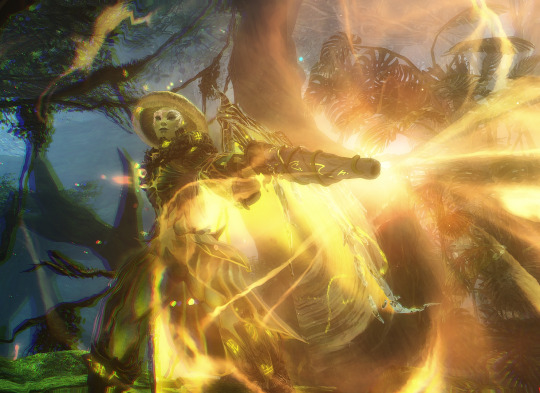
Flourish AU - Dragonheart Pirkko - Durmond Priory
Champion of the Caustic Elder Dragon
"Lasting change isn't gentle. It's harsh, abrasive, and inescapable. Either we'll adapt or we'll die trying."
"A better world starts with deciding what we're prepared to lose."
#my posts#guild wars 2#gw2#gw2 fan submission#Dragonheart Pirkko#Flourish AU#with all the sales going on i finally finished her look#she needed the maguuma shoulders + wanderer mask#(the wanderer mask NEVER goes on sale so if you want it you better grab it like Now. no really look at the gemstore history)#(it hadn't even been in the store at all since 2022 and this is the first time it's ever been on sale I Am Not Joking)#the only thing i wish is for a Vlast variant for the Aurene leggies for her but oh well. not every dream will come true.#i really gotta talk about this particular AU sometime tho tbh...#in Regrowth she's afraid of what she is and could become.#in Flourish though? she accepts even the parts that scare her. her power isn't something to fear. it's a tool and a weapon.#the blood of the jungle dragon flows through her veins and Tyria WILL hear her ROAR. her ENEMIES should be afraid.#she becomes the Champion of Vlast for a lot of reasons but the most significant is that they're so much alike.#neither has ever been anything other than the destiny that was set before them... and they don't know who they are outside that context.#they're trapped in roles they were molded for since their first breath. they barely understand the world they were built to save.#and yet... in spite of it all. they continue on. they do what they must. they fight for those who can't fight for themselves.#they're going to figure it out together... because in this big bright bold world they're the only two that REALLY understand each other.#they want to leave the world better than it was for them.#... even if they likely won't survive to see that happen.#the future will be better because it has to be. it must be. otherwise what have they spent their entire lives fighting for?#they don't belong to this world... but they can still build a better one. one that won't need anyone like them ever again.#I have... many thoughts about these two...
28 notes
·
View notes
Text
THE TOP 10 BEST FILM OF 2022
HONOURABLE MENTIONS
GLASS ONION
Rian Johnson proves he’s still got the touch with another subversively comedic addition to the Knives Out franchise. He delivers the twisty mystery, unique characters, and witty dialogue we know and love from the predecessor. There are side splitting gags galore from the characterizations (Dave Bautista as an MRA influencer who still lives with his mom) and the dialogue (“Please tell me you don’t think sweatshops are where they make sweatpants”).
DECISION TO LEAVE
On the surface, Decision to Leave is a modern film noir about a kind detective who develops an infatuation with a femme fatale after her husband falls off the top of a mountain. But as you would expect from a Park Chan-Wook film, the film becomes something much more.
ALL QUIET ON THE WESTERN FRONT
Decades after the original best picture winning classic, Edgar Berge adapts Erich Maria Remarque’s classic anti-war story of a small group of eager young Germans who enthusiastically sign up to fight during WW1 only to be destroyed by the horrors of war. Many films show the devastation of war and its traumatic effects, but this film showcases the terror of being in the battlefields.
PUSS IN BOOTS: THE LAST WISH
Puss competes against a group of baddies to reach a wishing star in the sequel nobody asked for that ended up being way better than it had any right to be.
First, it uses Spider-Man: Into the Spider verse’s animation technique to create an animation style that resembles illustrations come to life and create some dazzling action scenes. It also gives Puss some unforgettable villains ranging from the hilariously sociopathic Big Jack Horner (John Mulaney) to Dreamwork’s most terrifying villain the Wolf (Wagner Moura). Finally, it gives Puss some depth as he is forced to confront his mortality and how his obsession with his legacy has kept him from forming meaningful connections.
TAR
Cate Blanchett gives one of the year’s best performances as a narcissistic and well-respected composer whose actions eventually comes back to haunt her.
THE TOP 10 LIST:
10) THE MENU
Satirical Comedy and unsettling horror make strange bedfellows in this unique tale of a Margot (Anya Taylor-Joy), an average woman who joins her foodie boyfriend (Nicholas Hoult) to an all exclusive dinner led by renowned chef Julian Slowick (Ralph Fiennes). What they don’t know is that Julian plans to deliver some just desserts for his latest customers.
The plot plays like a mystery. With each dish served, we try to guess what Slowick’s got planned for these elites. And Slowick’s motives grow more and more unsettling. It’s best to go in knowing as little of the movie as possible.
The actors are more than game for their respective performances. Fiennes is unsettling as a stern perfectionist who has a bone to pick with all of them. Taylor-Joy makes the perfect audience surrogate as she calls out the absurdity of the food arrangements. The rest of the cast play into the caricatures of their characters from Hong Chau as Slowick’s fanatical waitress to Janet McTeer as a pretentious critic. Hoult in particular relishes his role as a devoted know-it-all. Just the scene of him crying over tasting bread accompaniments without the bread is sure to bring a snicker.
This film ruthlessly mocks the elitist foodie culture. Most of the customers care more about the status than the meal, never just enjoying the dishes. With each dish, Slowick calls the customers out on their privileges.
Available on Disney+
9) THE BANSHEES OF INISHERIN
In a small village in WW1 era Ireland, Padraic Suilleabhain (Colin Farrell) and Colm Doherty (Brendan Gleeson) spend their days enjoying glasses of Guinness at the local pub. But then one day, Colm decides he doesn’t like Padraic anymore and cuts him out of life to focus on making music. But the daft and offended Padraic can’t seem to take a hint much to Colm’s annoyance and Padraic’s spitfire sister Siobhan (Kerry Condon) chagrin. The locals aren’t much help, with many prying to know more about this incoming feud..
After earning acclaim (and some awards) with his Hollywood features Seven Psychopaths and Three Billboards Outside Ebbing, Missouri, writer/director Martin McDonagh returns to his roots and reunites his In Bruges stars Farrell and Gleason. McDonagh brings his trademark dark comedy to a folksy environment from his biting dialogue (“If punching a policeman is a sin then we may as well pack up and go home”) and surprising violence.[1] It also fits into McDonagh’s reoccurring theme of men who are unable to handle emotional moments like mature adults. While it can be devastating for a friend to sever ties with you, but Padraic can be clingy. Colm isn’t helping matters by threatening self-mutilation. Farrell and Gleason’s performances prevent these two from being unbearable. Farrell stands out by bringing a childlike eagerness and naivety that makes Padraic likeable.
At the same time, McDonagh regards these characters with empathy. He shows as much understanding for Padraic’s gratefulness for his simple life as he does with Colm’s need to create a legacy through his music.
Also, McDonagh does an excellent job of creating a sense of environment with the village. There’s also a strong sense of community in this village, with everyone knowing each other. There is also a unique set of personalities in this village, from the eccentric old Mrs. McCormick (Sheila Flitton) to the timid Dominic Kearney (Barry Keoghan). This simple area feels like a warm and inviting home many would like to live in.
The Banshees of Inisherin is a dark delight.
8) THE BATMAN
Who would have thought that there’d be a Batman movie that could pull off the feel of a David Fincher film? But Matt Reeves (along with co-writer Peter Craig) surprises the world with DC’s answer to Se7en and Zodiac. He brings the world a young Batman (Robert Pattison) in his second year who attracts the attention of the Riddler (Paul Dano), whose killing off key political figures in Gotham City. As he tries to get to the bottom of the Riddler’s murders, Batman comes to realize how corrupt Gotham’s world truly is and is forced to confront the sins of his father.
After two dark and gritty reboots of Batman and a post-pandemic world, this version really needed to impress. And it didn’t disappoint. Reeves delivers refreshing takes on every aspect of the iconic franchise. Gotham City has never looked seedier than it does in this film, with endless rain, decaying infrastructure and array of street gangs. This Batman we get is a young man who has let his Batman persona consume his life to the point where he barely has anything to do with Bruce Wayne.[2] But the most surprising update is the complete reinvention of The Riddler. This villain goes from being one of most mocked of Batman’s rogue’s gallery to being a Zodiac-like menace who seems to be constantly 10 steps ahead of everyone[3].
All these characters work because of the performances. Pattison proves himself a worthy Batman whether he’s interrogating Oswald (Colin Farrell) or taking down an army of muggers. Paul Dano weaponizes his everyman looks to hide an intimidating and sociopathic genius behind the green mask and distorted vocals. Farrell goes beyond the heavy makeup to create a ruthless, fast-talking version of the Penguin. Zoe Kravitz’ performance is probably the most comic accurate portrayal of Catwoman, especially when it comes to her dynamic with Batman. That’s not even getting into how Jeffrey Wright and Andy Serkis perfectly capturing the essences of Jim Gordon and Alfred respectively.
There’s also way more focus on the Detective aspect of Batman than in most versions. While we do see him in some kickass action scenes, for the most part, we see the World’s Greatest Detective use his sleuthing skills to solve the Riddler’s twisted riddles and investigate crime scenes. This brings more focus on the intrigue of the mystery.
And that score. That glorious musical score. Michael Giacchino delivers an epic, booming score worthy of joining the batman scores provided by Danny Elfman and Hans Zimmer.
It’s not a perfect movie. The biggest problem is the running time, which can lead to some dragging scenes that will be too much for some audiences. But the strengths of the film make up for these flaws. Here’s hoping Reeves keeps this up for the inevitable sequel.
Available on Crave
7) BOILING POINT
Writer/Director Philip Barantini seems to have taken a lesson from Uncut Gems on how to make a film feel like a relentless panic attack when he made Boiling Point; a tense drama about a stressed-out head chef (Stephen Graham) trying to get through the busiest night of the year.
Barantini and cinematographer Matthew Lewis make the risky move of shooting the whole film in a single take. It is easy for this to become gimmicky, but they use it effectively to emphasize how stressful it is to work in a restaurant. As the camera moves across the kitchen and into the dining area, it’s clear there’s no escape from the stress not even when head chef Andy Jones heads to his office to try and catch his breath. The rumbling of the kitchen as Andy sits alone in his desk makes it clear he has nowhere to hide.
Barantini also keeps the stress going by surrounding the environment with multiple clashes. The dishwasher’s upset that her replacement is hours late. The sous chefs and head waiter are at each other’s throats. Andy’s co-owner has invited a critic to dine with him. Barantini does an excellent job of balancing the multiple storylines within the short 92-minute screen time. He even manages to create some satisfying set ups and payoffs. One perfect example is a reoccurring arc with one chef whose constantly being told to roll up his sleeve. The revelation behind this arc with stay with you.
Boiling Point has a phenomenal cast who all deliver compelling performances as they scream over each other trying to get their point across. Usually typecast as the villain, Graham delivers his best performance as a man trying to keep it together while his life is going down the tubes. He makes you feel his hopelessness and overwhelming strain as he downs bottles of whisky, trying to get through the day. Even at his most self-destructive moments, you feel for him.
The result is a drama that does a better job of keeping the audience at the edge of their seat than most thrillers wished they could.
6) RRR
With the growing interest in Tollywood films, RRR makes the perfect gateway drug. Rarely in recent years has there been an action film so unapologetically epic as RRR, which has broken into the mainstream.
As with many Tollywood action films, Director S.S. Rajamouli, co-writers Vijayendra Prasad and Sai Madhave Burra along with the cast and crew take every element of the epic action flick and turn them all up to eleven. In a time when there is a call for more flawed, relatable protagonists in movies, RRR gives us a duel of superhuman action heroes performing impossible feats of agility. The opening scenes alone have rebel leader Komaram Bheem (NT Rama Rao Jr) chasing a wolf and a tiger and misguided soldier Alluri Sitarama Raju (Ram Charan Teja) leaping over a fence and fighting a whole crowd to capture one suspect. Let’s see the Fast and Furious franchise have its heroes leap over a bridge on a motorcycle or a horse and swing on a rope carrying the Indian flag to rescue a boy from a fire.
While there is a pressure for films to keep any messages nuanced and subtle, RRR serves as a three hour middle finger to the British Empire. That empire is embodied by the mustache twirling Scott and Catherine Buxton (Ray Stevenson and Alison Doody) who literally kidnap a little girl and kill the mother in the first scene. There would have been a danger of the villains being cringe, but Stevenson and Doody savour their villainy like a classic Disney villain. Even they get in on the over the top violence, with Mr. Buxton firing a machine gun while flying out a crashing car. It makes their downfall more satisfying.
If that isn’t enough, RRR also has musical numbers as epic as the action scenes. They manage to appear in the unlikeliest of moments like a motorcycle/horse race and one character being tortured with a whip. Most notable standout is a dance off between the heroes and one snobby British soldier.
But at its core, RRR is a story about a friendship between two men who don’t realize that one’s supposed to arrest the other and a tale about a tribal leader on a mission to rescue a little girl from rich captors. The fact this film makes us care about story and keep the audience hooked over its long screentime shows the power of this epic.
Available on Netflix
5) THE NORTHMAN
After taking the horror genre by storm with The Witch and The Lighthouse, writer/director Robert Eggers gives us something completely different with The Northman. In contrast to his previous low budget A24 arthouse horror flicks, Egger’s latest is a big budget epic historical action flick. It may be his most accessible film, but that doesn’t stop him from bringing his boundary pushing style into this film.
The Northman is Hamlet-like revenge tale of Almeth (Alexander Skarsgaard), a Viking prince who seeks vengeance on his uncle Fjolnier (Claes Bang) who kills his father King Aurvandil (Ethan Hawke) and marries his mother Queen Gudrun (Nicole Kidman). After years in exile, Prince Amleth disguises himself as a slave and enlists the help of an enchantress (Anya Taylor-Joy) to bring down the King Fjolnier the Brotherless.
Eggers brings a refreshing take on the Viking historical drama with his trademark style. Like his previous films, Eggers (along with his co-worker Sjon) goes out of his way to make his stories as historically accurate as possible. As a result, we get the ugliest side of the Viking life. The images of people in chains makes it clear that Amleth’s family owns slaves. When Amleth’s in exile, he joins a group of Vikings in pillaging and terrorizing innocent people. In one horrifying scene, those Vikings trap women and children in a cottage and burn it down. Keep in mind that the protagonist watches this happen.
What’s strange is that Eggers also includes fantastical moments that draws from Norse Mythology. The result is otherworldly imagery of Amleth meeting with the Seeress (Bjork). It doesn’t seem like this should work, but somehow these elements make strange bedfellows.
Unlike his previous films, Eggars doesn’t go for historically accuracy with the dialogue. As a result, the audience has a better grasp of what the characters are saying. The dialogue is still kind of Shakespearean but just enough to the characters are still easy to understand.
Of course, the action scenes are awesome with the blood and dismemberment you expect from an R-rated movie with Vikings. It leads to a most metal ending with Amleth and his uncle going head-to-head in a volcano in their birthday suits.
With this film bombing at the box office, it’s doubtful Eggers will ever have the means to make a film as epic as this one.
Available on Crave
4) GUILLERMO DEL TORO’S PINOCCHIO
2022 was the strange year where we got three Pinocchio movies in a row. After listening to Pauly Shore butcher lines and Disney butcher their original classic, most moviegoers knew Guillermo Del Toro’s stop motion version would be the best one by default. But even without the other two films, there would still be major anticipation for Del Toro’s first animated feature film. With his trademark fleshed out mythology, creative character designs and compelling storytelling, many expected him to perfectly capture the macabre tone of Carlo Collodi’s tale. What we got is a refreshing take on the classic take on the wooden boy who longs to be a real boy.
Del Toro (alongside codirector Mark Gustafson and co-writers Patrick McHale and Matthew Robbins) perfectly balances capturing the story’s dark tone and core storyline while changing many elements of the story. This Pinocchio (Gregory Mann) is a lot closer to the disobedient troublemaker of the original story than Disney’s sweet but gullible character. Like Collodi’s tale, this story has our hero causing grief for his creator/father Geppetto (David Bradley), being led astray by crooks and trouble making teens only to suffer the repercussions before the climax of trying to escape from inside the whale. It even includes both the Christian undertones of the original story and even its dark comedy (among them a reoccurring gag of Sebastian the Cricket (Ewan McGregor) constantly being squashed.) It also borrows a bit from the Disney version with the Blue Fairy (Tilda Swinton) bringing the puppet to life and the cricket trying to guide him.
But this film also makes a lot of changes from the original story. First, Del Toro sets the film in Italy during Mussolini’s reign. Not only does this fit into Del Toro’s reoccurring theme of life under fascism, but it brings nuance to the original story’s message of obeying your parents. While the film does have Pinocchio deal with consequences for misbehaving, the film also shows the dangers of blinding obeying those in power and makes the case that disobedience is necessary when it involves doing the right thing. The film also fleshes out the characters to bring complexity. While Pinocchio is still a disobedient troublemaker, he also has his heart in the right place and will stick up for others. Geppetto is a broken man grieving the loss of his dead son Carlo (also Mann). Sebastian is a wannabe writer who makes his home in Pinocchio’s chest. Del Toro also brings in an array of unique characters from ruthless ringmaster Count Volpe (Christoph Walz) to terrifying fascist enforcer Podesta (Ron Pearlman). All the actors do excellent jobs of making their characters engaging, especially Mann.
Co-Director Mark Gustafson perfectly brings Del Toro’s trademark style into the animation world, resulting in some unique visuals. Pinocchio has never looked more wooden with spiky wooden hair, tiny black dotted eyes, and multiple nails in his back. The Blue fairy aka the wood sprite (also Swinton) is this otherworldly blend of Hari Krishna and a mermaid. Death is this sphinxlike creature in a world of blue sand. What’s most notable is how the settings and character design resemble classic storybook illustrations come to life.
The film is also a musical, with songs created by composer Alexandre Desplat alongside Del Toro and lyricist Roeban Katz. The old timey style perfectly serves to further the narrative and reveal more about the characters, but they don’t stand out the way Encanto’s songs did. The one exception is “Ciao Papa.” When Pinocchio pours his heart out to his long distant father, you can feel that longing so much it may bring you to tears.
No wonder many see this as the front runner for the Best Animated Feature Oscar.
Available on Netflix
3) AFTERSUN
Most filmmakers try to make their films memorable. Aftersun is a rare film that feels like a memory.
On the surface, it’s a simple story of a single Dad (Paul Mescal) and his daughter (Frankie Corio) taking a trip to a Turkish beachside resort. There is no real plot. No central conflict. It’s just segments of a father and daughter on vacation. At least, that’s what it seems like at first. Hidden in plain sight are signs of the father hiding some personal pain from his daughter.
In her debut feature, writer/director Charlotte Wells takes us into segments of this vacation, even replaying some moments on camcorder. The result is a film that feels like we’re entering the daughter’s memories as she tries to understand her father.
The strength of Wells’ filmmaking is how she avoids the temptation to dramatize any element of the plot in favour of making it as naturalistic as possible. Never does she make it clear what the dad’s going through. You only get the most subtle of hints. She only applies any artistry with the ending that will stay in your mind long after the credits roll.
That’s helped by the performances by the two leads. Mescal and Corio bounce off each other perfectly, making us believe they are an actual family. They both also maintain low key naturalization throughout the film.
Put all these together and you get an unassuming drama that stays with you long after the credits roll.
2) (TIE) BEFORE I CHANGE MY MIND, GOLDEN DELICIOUS AND YOU WILL LIVE FOREVER
I admit that I have a habit of putting ties in my lists, not helped by me including a three-way tie in this one. But these 3 films have so much in common that I felt they deserve to be put together. Well, that and these are probably the least known films on this list, and I feel they deserve more attention.
All three are Canadian films centered on LBGT teens who move into new locations, which leads to developing deep relationships. They’re similar yet different. The most important commonality are the compelling stories of relatable, flawed young people trying to fit into their world and figure out what they really want in life in the process.
First, we have Before I Change My Mind. Set in 1987, the movie centres on Robin (Vaughn Murrae), a non-binary preteen who moves to a small Albertan town from the US with their father (Matthew Rankin). There are of course questions from the students what Robin’s gender is. To fit in, Robin tries to befriend the school bully Carter (Dominic Lippa). On one hand, it makes it easier for Robin to form friends. On the other, it leads to Robin making misguided decisions.
Director Trevor Anderson and co-writer Fish Griwkowsky capture the everyday life of preteens as they make snide comments during music class, pick fights with each other and just hanging around in the living room. What makes this film special is how it captures the difficulties of being a preteen. Robin and their classmates try their best to fit in with their peers. Sometimes it can be found in healthy activities like hanging around in the mall. Other times it comes from misguided decisions including sneaking into their parents alcohol or in one student’s case, completely changing his personality after being bullied.
The film also captures the frustration of dealing with emerging emotions you have no understanding of and now healthy means of channeling them. That’s especially true with Robin who has no idea of their own gender identity since non-binary wasn’t a common term in the 80s. As a result, they become targets for fellow classmates who keep demanding to know if they are a boy or a girl.. Being non-binary themselves, Murrae makes the audience feel how lost Robin feels. Anderson and Griwkowsky do an excellent job of using subtext to capture this feeling. And they never offer any easy answers.
There are also some funny moments in the film. When gym class separates the boys and girls, Robin sits in the middle. Robin and Carter try to convince a drag queen (dressed like Madonna) to buy them beers. But the comedic high point is the school’s disastrous rock musical rip-off of Jesus Christ Superstar.
Next, we have Golden Delicious. Jake (Cardi Wong) seemed to be living the perfect teen life as a basketball player whose relationship with his girlfriend Valerie (Parmiss Sehat) is popular on social media. But he finds his life turned upside down when new student Aleks (Chris Carson) moves next door. As Jake and Aleks both train for the basketball team, Jake is forced to confront the pressure his father George (Ryan Mah) places on him.
Director Jason Karman (through Gorrman Lee’s screenplay) channels his youth to capture the pressure of having to live up to expectations. Jake tries his best to please his father, despite not being the best skilled in the team. Georges’s pressure is embodied by the old, decaying basketball hoop he forces Jake to practice on. Through Aleks, Jake’s confronted with the fact that he has never learned to live for himself.
Lee also fleshes out Jake’s family, who is dealing with their own pressure. George and his wife Andrea (Leeah Wong) are trying to keep their Chinese restaurant afloat, but the stress of running the restaurant has taken its toll on Andrea. When their daughter Janet (Claudia Kai) discusses her interest in being a chef, Andrea tries to forbid her. Janet has her own arc where Janet tries to create her late grandma’s dishes. This family feels so achingly human and relatable.
Of course, there’s excellent chemistry between Wong and Carson as their characters build from a friendship into a relationship.
And finally, we have You Can Live Forever. Rebellious teen Jaime (Anwen O’Driscoll) is forced to live with her aunt Beth (Liane Balaban) while her mother recollects herself after her husband’s death. Beth is a Jehovah’s Witness whose husband Francois (Antoine Yared) hopes to be the leader of his congregation. While being forced to attend sermons, Jaime develops a friendship with fellow devout Marike (June Laporte). Soon that develops into something more, which is risky in a homophobic fringe community.
A romantic film like these lives and dies on the chemistry between the leads. When two leads have such differing personalities/worldviews, it’s very important that the two leads have convincing chemistry for the relationship to make sense. O’Driscoll and Laporte pull that off beautifully, conveying a warm intimacy between Jaime and Marike as they hide in plain sight with little intimate gestures. It helps that both actresses make their characters feel like real people. O’Driscoll portrays Jaime as a typical teen whose big glasses and grunge wardrobe hides a slightly rebellious teen frustrated at being stuck in a situation outside of her control. Laporte makes Marike a timid girl devoted to her religion yet forms an infatuation with Jaime. Writer/Directors Mark Slutsky and Sarah Watts avoid the temptation of melodrama in favour of grounded empathy. They allow us to understand what Marike finds in her faith while showing how it can be stifling for Jaime.
All three deliver achingly human stories of young people trying to find what they truly want in life.
1) EVERYTHING, EVERYWHERE ALL AT ONCE
In a time when franchises consume movie theatres, Everything, Everywhere All at Once came out of nowhere to deliver an everything bagel the zeitgeist can sink its teeth into.
Evelyn (Michelle Yeoh) finds herself dissatisfied with her life as a struggling Laundromat owner, further aggravated by her goofball husband Waymond (Ke Huy Quan), her contentious relationship with her daughter Joy (Stephanie Hsu) and her overly critical father (James Hong). If that wasn’t bad enough, she’s being audited by the IRS, forcing her to deal with an austere IRS agent (Jamie Lee Curtis). Suddenly, Evelyn finds Waymond possessed by an alternate version of himself and Evelyn’s tasked with saving multiple universes from the mysterious and all powerful villain known as Jobu.
The Dynamic Duo of Daniel Kwan and Daniel Scheinert already proved their originality with their music video Turn Down for What and their feature film debut Swiss Army Man. Who would have thought they could create an existential tale of a mother daughter relationship involving googly eyes, hot dog fingers and a ratatouille parody?
As you expect from the Daniel’s previous works, it delivers on the weird and hilarious imagery (often involving leud objects). One minute, Waymond is gluing googly eyes on everything, and the next he’s taking down security guards with a fanny pack. That’s just one of many examples of the creative and well-choreographed fights scenes the Daniel’s have in store for the viewers. Only they could image fight scenes either involving Waymond intentionally giving himself paper cuts or henchmen trying to shove a trophy up where the sun don’t shine.
With moments like these, you would never expect anything profound in the film. And yet, the Daniels somehow balances these silly moments with deep, philosophical themes. Evelyn comes to realize how the little choices she made in life can have major outcomes after glimpsing versions of herself as a famous actress, a kung fu artist and a chef. Her journey also forces her to reexamine her perceptions of her husband and reconcile her relationship with her daughter. The battle between Evelyn and Jobu shows how perception can alter how one handles the meaningless of life. It’s surprising how deep this film can get.
The result is a cinematic miracle that delivers a truly unique experience.
Available on Prime Video
[1] When Colm threatens to cut off his fingers if Padraic talks to him again, you know a finger’s going to come off at some point.
[2] So consumed that he only has around 3-4 scenes as Bruce Wayne. It’s funny. In his Godzilla reboot, he barely showed the iconic monster on screen. For The Batman, we get all the caped crusader we could ever want.
[3][3] He also seems to be doing a better job of getting rid of corruption than Batman is.
#top 10 films of 2022#random richards#everything everywhere all at once#before I change my mind#;Golden delicious#you can live forever#aftersun#pinocchio#Guillermo Del Toro#the northman#rrr fanfic#rise roar revolt#boiling point#the batman#the banshees of inisherin#the menu#tar#puss in boots#the last wish#all quiet on the western front#decision to leave#glass onion#a knives out mystery#knives out#movie review#review#daniel kwan#daniel scheinert#michelle yeoh#Trevor Anderson
122 notes
·
View notes
Text
I want RRR to re-release in theatres right now. I have never regretted missing a movie in the theatres as much as I do for this movie. I will literally sell my soul to get the chance again. Please God, I will never ask anything from you ever again 😭
#the beginning of 2022 was such a shit time for me#movies? what movies? my life was a shitshow#personal#rrr#rise roar revolt
6 notes
·
View notes
Text
overmorrow fun fact: it originally had humans/furries but then i changed it becaues i dont like making human ocs and i had too many furries so it was imbalanced in away i didnt like ....... but i still like hte idea of a world with humans and furries coexisting . i like making oc worlds with my friends..that could be an opportunity for us to make, like humans/furries world
#actual furries i mean obviously. anthro animals people..not..furries on earth unfortunately u_u#LOL#i need to find out overmorrow's bday#i made it in likee...mid 2022#alot of my oc stuff is relatively new bc i only became oc brained like 2 years ago haha#thunder roars#overmorrow
8 notes
·
View notes
Text
8 notes
·
View notes
Text
the batman batmobile scene was for the car fuckers how are we feeling car fuckers
3 notes
·
View notes
Text
Rookie-Critic's Top 25 Films of 2022: #7: RRR (dir. S. S. Rajamouli)

I can't even begin to describe how much fun I had while watching RRR. To call this film a roller coaster ride of action and emotion would be a criminal understatement. Now, I'm not the biggest fan of Bollywood/Tollywood films, more out of ignorance than anything else, really. It just always seemed like an impenetrable wall of wacky stories, musical numbers, and offbeat camerawork. It just never seemed like my kind of thing, so I've never really taken the dive into that world. This film single-handedly turned that opinion around, and now I'm hungry for more. The story of two friends who, unbeknownst to each other, are actively trying stop the other from accomplishing their goal is packed to the brim with unforgettable action sequences as well as musical numbers that, and I can't stress enough how much I normally don't like this kind of thing, are some of the best I've ever seen in film. With a runtime slightly exceeding three hours, I can honestly say I was never once bored. This film is entertaining, it's moving, it's inspiring, it's funny, and most importantly, it's exceptionally well-made. Director S. S. Rajamouli (who, unbeknownst to me until after I finished the film, directed the only other Tollywood film I've seen and loved, Eega) is a master craftsman behind the camera, and the cinematography (done by K. K. Senthil Kumar) is phenomenal. The action sequences are awe-inspiring, the musical numbers are fun when they need to be (see the Academy Award-winning song "Naatu Naatu" for confirmation) and moving when they need to be, the dramatic scenes hold the perfect amount of drama without slipping into camp or melodrama. Almost everything about RRR works. Even the English-language actors do a pretty good job which, from what I've seen of big-budget foreign cinema that employs English-language actors, that is not always the case. They're not the most subtle or eloquent actors in the world, but they play their parts well, and nothing about RRR is subtle, anyway (although it is eloquent). This film is brash and bold and as in-your-face as it can be, but the whole time it's doing this you are absolutely along for the ride. I said this in my original review and I will say it again here, I am purposefully talking around plot-specific details because I am of the strong opinion that everyone should walk into RRR as blind as possible for the maximum amount of enjoyment to happen. It's so much better when you have no idea how over-the-top it can get, and trust me, you have no idea how over-the-top this can get. I absolutely hate the fact that Netflix owns the North American distribution rights for this film, because that means it will probably never get a Region 1 Blu-ray (or, even sadder, a 4K edition), and I am forever stuck with either watching the Telugu-language file I have, or watching the Hindi-dubbed version of the film on Netflix. It's a shame, because that is absolutely one of the best films of last year and without a doubt the best action film of last year.
The Hindi-dub of the film is currently streaming on Netflix. The Telugu version, for those committed to watching through more "official" channels, is currently streaming on the ZEE5 Global streaming service.
You can read my original review of RRR here.
#The Top 25 Films of 2022#RRR#Rise Roar Revolt#S. S. Rajamouli#SS Rajamouli#S.S. Rajamouli#N. T. Rama Rao Jr.#Jr NTR#NTR Jr#Tarak#Ram Charan#Samuthirakani#Olivia Morris#Ray Stevenson#Alison Doody#Ajay Devgn#Alia Bhatt#Chatrapathi Sekhar#Makarand Deshpande#Rahul Ramakrishna#Edward Sonnenblick#Twinkle Sharma#film review#movie review#2022 films
3 notes
·
View notes
Text


2022 was the Year of the Old Cowboy
#fic coming soon#i didn't notice this until now#lol#i mean i take both#in more ways than one#😏😏😏#didi chill lol#girl stop#save a horse ride a cowboy#am i right?#i like me some old outlaws#it's one of my kinks#and it's as strong as my priest kink#calm down girl#joe cribbens#dead for a dollar#silas mccall#roar (2022)#willem dafoe#alfred molina
78 notes
·
View notes
Text
I just revisited "Christmas Kids" by ROAR
Holy fuck, I forgot how deep it was. I relistened to it after watching WURLD's video on it, and I also listened to her kick ass cover. Listening to that song with the context is life changing, I almost cried. Go stream it if you like peak
0 notes